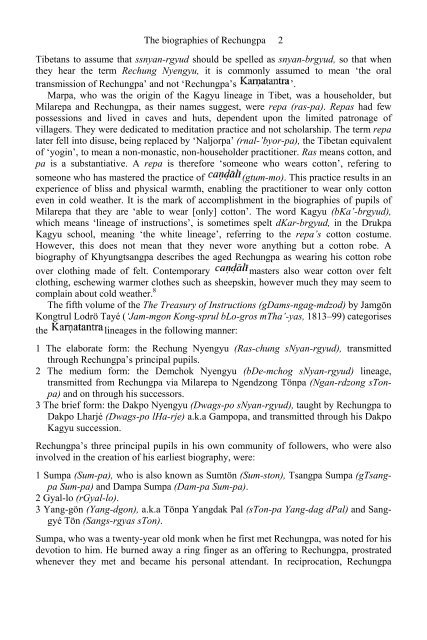The Biographies of Rechungpa: The Evolution of a Tibetan ...
The Biographies of Rechungpa: The Evolution of a Tibetan ...
The Biographies of Rechungpa: The Evolution of a Tibetan ...
You also want an ePaper? Increase the reach of your titles
YUMPU automatically turns print PDFs into web optimized ePapers that Google loves.
<strong>The</strong> biographies <strong>of</strong> <strong>Rechungpa</strong> 2<br />
<strong>Tibetan</strong>s to assume that ssnyan-rgyud should be spelled as snyan-brgyud, so that when<br />
they hear the term Rechung Nyengyu, it is commonly assumed to mean ‘the oral<br />
transmission <strong>of</strong> <strong>Rechungpa</strong>’ and not ‘<strong>Rechungpa</strong>’s ’.<br />
Marpa, who was the origin <strong>of</strong> the Kagyu lineage in Tibet, was a householder, but<br />
Milarepa and <strong>Rechungpa</strong>, as their names suggest, were repa (ras-pa). Repas had few<br />
possessions and lived in caves and huts, dependent upon the limited patronage <strong>of</strong><br />
villagers. <strong>The</strong>y were dedicated to meditation practice and not scholarship. <strong>The</strong> term repa<br />
later fell into disuse, being replaced by ‘Naljorpa’ (rnal-’byor-pa), the <strong>Tibetan</strong> equivalent<br />
<strong>of</strong> ‘yogin’, to mean a non-monastic, non-householder practitioner. Ras means cotton, and<br />
pa is a substantiative. A repa is therefore ‘someone who wears cotton’, refering to<br />
someone who has mastered the practice <strong>of</strong> (gtum-mo). This practice results in an<br />
experience <strong>of</strong> bliss and physical warmth, enabling the practitioner to wear only cotton<br />
even in cold weather. It is the mark <strong>of</strong> accomplishment in the biographies <strong>of</strong> pupils <strong>of</strong><br />
Milarepa that they are ‘able to wear [only] cotton’. <strong>The</strong> word Kagyu (bKa’-brgyud),<br />
which means ‘lineage <strong>of</strong> instructions’, is sometimes spelt dKar-brgyud, in the Drukpa<br />
Kagyu school, meaning ‘the white lineage’, referring to the repa’s cotton costume.<br />
However, this does not mean that they never wore anything but a cotton robe. A<br />
biography <strong>of</strong> Khyungtsangpa describes the aged <strong>Rechungpa</strong> as wearing his cotton robe<br />
over clothing made <strong>of</strong> felt. Contemporary masters also wear cotton over felt<br />
clothing, eschewing warmer clothes such as sheepskin, however much they may seem to<br />
complain about cold weather. 8<br />
<strong>The</strong> fifth volume <strong>of</strong> the <strong>The</strong> Treasury <strong>of</strong> Instructions (gDams-ngag-mdzod) by Jamgön<br />
Kongtrul Lodrö Tayé (‘Jam-mgon Kong-sprul bLo-gros mTha’-yas, 1813–99) categorises<br />
the lineages in the following manner:<br />
1 <strong>The</strong> elaborate form: the Rechung Nyengyu (Ras-chung sNyan-rgyud), transmitted<br />
through <strong>Rechungpa</strong>’s principal pupils.<br />
2 <strong>The</strong> medium form: the Demchok Nyengyu (bDe-mchog sNyan-rgyud) lineage,<br />
transmitted from <strong>Rechungpa</strong> via Milarepa to Ngendzong Tönpa (Ngan-rdzong sTonpa)<br />
and on through his successors.<br />
3 <strong>The</strong> brief form: the Dakpo Nyengyu (Dwags-po sNyan-rgyud), taught by <strong>Rechungpa</strong> to<br />
Dakpo Lharjé (Dwags-po lHa-rje) a.k.a Gampopa, and transmitted through his Dakpo<br />
Kagyu succession.<br />
<strong>Rechungpa</strong>’s three principal pupils in his own community <strong>of</strong> followers, who were also<br />
involved in the creation <strong>of</strong> his earliest biography, were:<br />
1 Sumpa (Sum-pa), who is also known as Sumtön (Sum-ston), Tsangpa Sumpa (gTsangpa<br />
Sum-pa) and Dampa Sumpa (Dam-pa Sum-pa).<br />
2 Gyal-lo (rGyal-lo).<br />
3 Yang-gön (Yang-dgon), a.k.a Tönpa Yangdak Pal (sTon-pa Yang-dag dPal) and Sanggyé<br />
Tön (Sangs-rgyas sTon).<br />
Sumpa, who was a twenty-year old monk when he first met <strong>Rechungpa</strong>, was noted for his<br />
devotion to him. He burned away a ring finger as an <strong>of</strong>fering to <strong>Rechungpa</strong>, prostrated<br />
whenever they met and became his personal attendant. In reciprocation, <strong>Rechungpa</strong>











